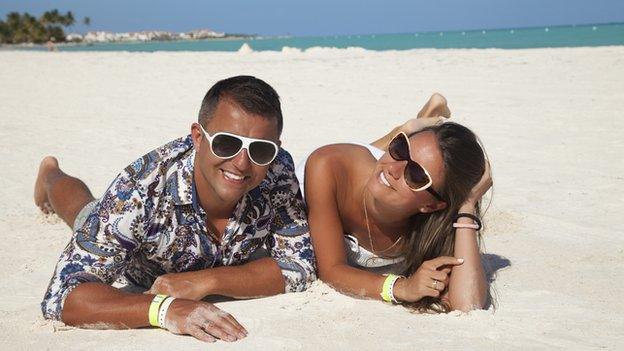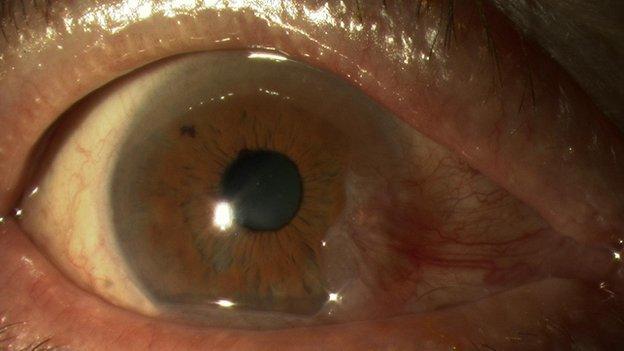Sun 'can harm sight as well as skin'
- Published

Sunglasses are essential when heading to the beach
When the sun is shining, life can seem a little bit better. But the sun's ultraviolet rays can cause us harm.
Many people regularly apply sunscreen to prevent skin damage and enjoy the sun in safety. But experts say it's just as important to protect our eyes and wear sunglasses.
Just as the sun can burn our skin, it can burn the surface of the eye, and exposure to ultraviolet (UV) rays has also been linked to serious eye conditions.
A pair of sunglasses is therefore an essential item when packing to head to the beach.
Keeping safe in the sun
The eye is relatively well protected. It is set back in the skull - and is shielded by the brow ridge, the eyebrows and the eyelashes.
But this natural protection is limited, especially under extreme conditions.
Raj Das-Bhaumik, a consultant ophthalmic plastic surgeon at Moorfields Eye Hospital, London, says: "We are exposed to UV light in greater amounts in the summer months, at altitude and whilst out in open water.
"Snow and water reflect light including UV so the exposure is greater."
He added: "Eye protection by way of sunglasses or goggles is recommended to prevent damage from UV light, especially when we are exposed to UV light for prolonged periods of time."

Choosing sunglasses with adequate UV protection is recommended
UV damage in the eye builds up over time.
"The body has a remarkable ability to repair itself. This reduces over time and the damage on a cellular level may become additive over time," Mr Das-Bhaumik says.
Although it would be unethical to do experiments about the damage that UV can cause on people, evidence of the harmful effects of UV on the human eye comes from epidemiological studies.
These look at different populations who naturally have different levels of UV exposure due to factors such as geography or lifestyle.
"By looking at large numbers of people we can make conclusions based on the average findings in these populations," he added.
'Surfers' eye'
Animal studies also indicate that UV rays have harmful effects on the eye.
There are a number of serious conditions associated with exposure to UV rays, including cancer, snow blindness and cataracts.
Although the links are known, more research is needed into the relationship between UV light and these conditions.
One condition also often associated with excessive exposure to UV ray is "surfers' eye" or pterygium; a benign growth of the conjunctiva, the thin, transparent tissue that covers the outer surface of the eye.

Mr Loizou developed a pterygium on his eye. It is thought that this may have been due to growing up in Cyprus.
Nicholas Loizou, aged 80, now lives in London, but it is thought that growing up in sunny Cyprus may have led to the development of the pterygium on his eye.
His daughter Christine took him to Moorfields to see Mr Das-Bhaumik. "It started to irritate him so the doctor referred him to the hospital. He's only got one eye because he had an accident as a little boy, so we need to look after the sight in that eye."
The science of sunglasses
Sunglasses lenses can block UV rays, preventing them from reaching your eye. Sunglasses are therefore key tools to help protect your eyes from UV damage.
UV protection is measured using a technique called spectrophotometry, which checks how much UV light is absorbed or reflected by the lenses and how much passes through and could enter your eye.
Sunglasses manufacturers have to abide by standards that state which UV rays should be blocked.
Stickers found on sunglasses let consumers know what UV rays the sunglasses block from your entering eyes, and can help you decide whether you are sufficiently protected.
Can you trust your sunglasses?
Prof Liliane Ventura, from the University of São Paulo, has spent almost two decades years scrutinising the protection that sunglasses can give. She has developed a machine that allows you to check whether your sunglasses are really giving you appropriate UV protection.
All you need to do is place your sunglasses into the machine and within a few seconds later information about the level of UV protection is displayed on the screen.
"It also makes recommendations of settings where the sunglasses provide adequate protection," explained Prof Ventura.
Whilst some sunglasses may be adequate for driving or every day activities, greater protection may be needed for in extreme UV conditions such as skiing and surfing.

Prof Liliane Ventura has developed a machine which tells you whether your sunglasses are providing adequate UV protection
So far there is one machine, located in Brazil.
But there are some general tips to remember when buying sunglasses.
'Wear sunglasses that are suitable for the occasion.
"Polarised sunglasses are recommended for use on water, wrap arounds in windy situations, or one with straps, for example, during sports activities,' explained Mr Das-Bhaumik.
"Check that they absorb to 400nm (sometimes labelled UV 400), if in doubt, take the sunglasses to an optometrist who can check the lenses for you as to how good they are at absorbing the harmful rays."